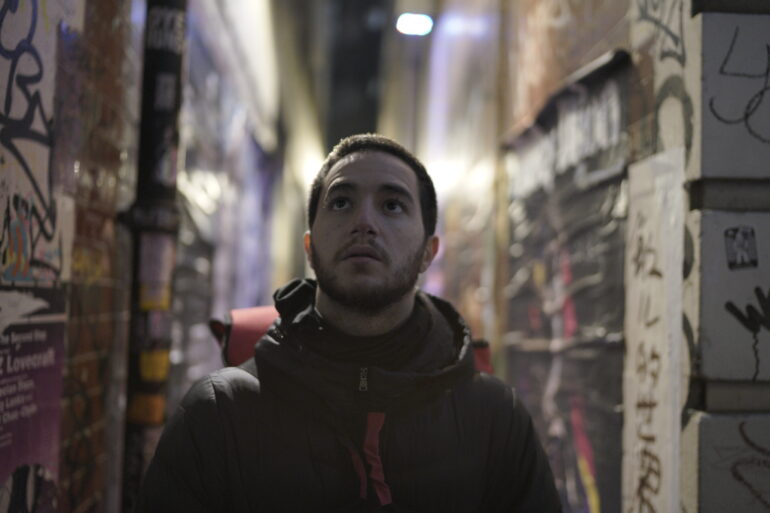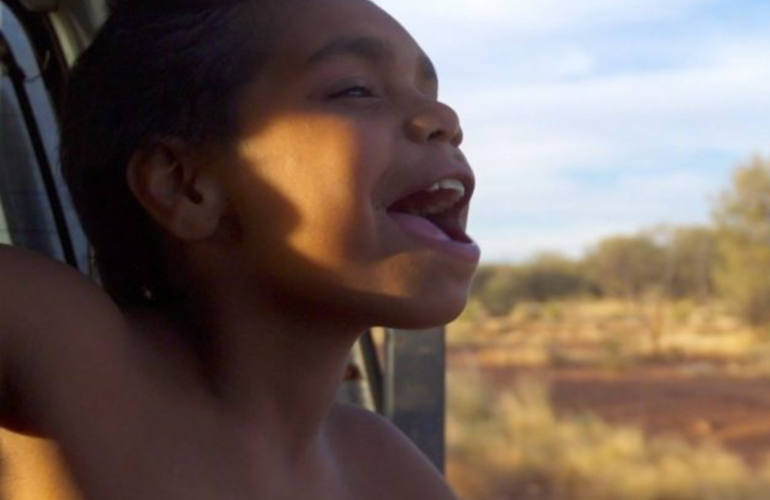“It’s not just about rediscovering lost films,” says Sula Douglas-Folkes, as her regal cat T’challa saunters elegantly across the laptop screen. “It’s about unearthing stories and amplifying voices that have been silenced for far too long.”
I’m on Zoom with the PhD student, producer, and film programmer, and her dedication to archive film is palpable. Sula’s PhD focuses on the under-explored landscape of Black women filmmakers and building a living Black film archive focusing on capturing history instead of restoration; a subject that had ignited her curiosity during her undergraduate studies.
When she begins speaking about “uncovering unseen and under heard stories, particularly in Black women’s film and filmmaking,” I immediately know that our conversation is going to be truly special.
Breathing life into film programming
When we speak, Sula’s just returned from her programming debut at Flatpack Festival, Birmingham’s independent film celebration known for its dedication to experimental narratives. Her excitement is tangible as she describes the vibrant energy in the room, a community united by their love for cinema that dares to push boundaries.
Sula screened two films for the performance, Eloyce Gist’s Hellbound Train (1930) and Diary of an African Nun (1977), written by Alice Walker and directed by Julie Dash. The audience’s experience transcended the simple act of watching a film, as they were transported to the 1930s and 1970s via a collective exploration, accompanied by a live, surrealist jazz composition by swaampcat (Ebunlola Adepoju).
Sula’s multi-disciplinary programming practice stems from her vast experience working in arts and film institutions like The Royal Court Theatre, We Are Parable, Animae Caribe and several voluntary stints. “There’s a movement afoot in film programming,” she says, excited. “I’m harnessing the power of the call and response, and looking at the curatorial registers of Black live-ness in and out of the film itself.”
As a screenwriter who should be critically analysing films when I watch them, I’ve been guilty of scrolling on my phone, and sometimes, between the subtitles and story beats, the mind wanders. Sula’s experimental approach to film programming aims to dispel short audience attention spans. She brings audiences together to uncover treasure troves of archive Black female film, and engages them in an immersive, multi-sensory experience, taking film programming to the next level.
I asked Sula why she chose to show those two films for Flatpack. “At 98 years old Hellbound Train is the oldest surviving film by a Black female filmmaker,” she answers. “I want to continue showcasing and preserving the film’s legacy.”
Sula explains to me that these films are significant not only due to their survival, but their unique storytelling. As Nicolas Pedrero-Setzer says in their commentary on the film, Diary of an African Nun opens new horizons for politically committed, artfully effusive films that centre female stories.
Faith and Blackness
This double feature at Flatpack encapsulated Black radical aesthetics and spirituality. Both films, punctuated with themes of racial oppression, morality and righteousness explore the impact of strict religiosity in Black churches on women. They underline how this can lead to the policing and control of women’s bodies, drawing parallels to current issues surrounding abortion laws in America and women’s autonomy worldwide that disproportionately affect Black women.
Diary of an African Nun is a poetic and introspective piece about a young Ugandan nun questioning her faith on the eve of her vow-taking. She meanders between her culture and her calling, conflicted with the presence and absence of Christ in her most intimate thoughts. She calls herself the “wife of a celibate martyr” and laments the emptiness that exists in the new reality that awaits her.
Against this backdrop, she ponders how she is viewed by American missionaries who are awed by her beauty, amidst the sounds of rhythmic drumming and nature sounds – she longs for everyday life and community.
Walker subverts the common representations of nuns’ daily lives – where prayer and devotion to God take centre stage – by exploring sexual independence and a longing for a life outside the convent. In tandem, Dash’s use of light and shadow created visual magic that transported viewers into the nun’s internal world, a world filled with questions surrounding belonging and purpose.
All aboard the Hellbound Train
Hellbound Train, a doomsday-esque story from the 1930s, was released in the jazz and prohibition era in the US. It is important to note that there are several released versions of Hellbound Train, with this one being one of the few that survived. Gist and her husband James travelled across the US screening the film at churches, alongside a live music accompaniment and sermon. They aimed to shock churchgoers, and share a stark warning to convince congregations to align more closely with God. “Imagine, a silent film from 1930, directed by a Black woman at a time when racial and gender barriers were high!” Sula says.
Though fragmented, it is a silent oddity brimming with symbolism. The action follows a man in a devil costume driving a speeding train hurtling towards hell, carrying passengers who committed sins of the time. Drunken businessmen, gambling fiends, cheating husbands, jazz listeners and most strikingly, women deemed “immoral” through abortion and promiscuity – all find themselves rolling towards an unknown fate.
For me, Hellbound Train was a humorous watch. I couldn’t help but draw parallels to my 2024 equivalent of the costumed character: a street evangelist with a megaphone who, at the start of my commute at Stratford station, shares the daily bad news that “we are all indeed going to hell.”
However, the film also tackles serious themes. The film’s condemnation of jazz music is contrasted by its powerful jazz score. This dissonance shows the strategic hypocrisy embedded within Gist’s evangelical practice, to draw in reluctant churchgoers who may have been hesitant due to the subject. This subversive element aligns with Sula’s mission to challenge dominant narratives and amplify the voices of filmmakers like Gist who created films at a time, and in an industry, that was unwelcome to them.
Archives of the future
These films are examples of stories that advocates like Sula work tenaciously to recover, offering a glimpse into filmmaking history and emphasising the crucial role of archives. Without them, these stories and the artistry of Black women filmmakers like Gist and Dash could be lost forever.
I ask Sula about her visions for the future, and she answers simply: “Bringing Black women’s voices to the fore.” She is actively working towards a future where Black women filmmakers are not just celebrated at niche festivals but embraced by mainstream cinema. She envisions a world where film archives overflow with their work, instead of consisting of a handful of rediscovered gems. This vision fuels her unwavering dedication to film programming, research, and her most ambitious project – building a living archive focused on Black women’s filmmaking.
This archive, envisioned as a living platform, wouldn’t just be a storehouse for films. It would be an influential hub, a space for dialogue, community, and most importantly, access. “Imagine a young Black female filmmaker,” Sula explains, “discovering stories by women who look like them, who share their experiences. That’s the power of this archive.”
Subscribe to shado's weekly newsletter
Exclusive event news, job and creative opportunities, first access to tickets and – just in case you missed them – our picks of the week, from inside shado and out.

An archive like this would have been an incredible resource for me as an aspiring screenwriter in my younger years. Before YouTube, I was completely unaware of a space to explore women who looked like me in film and media. Thankfully this started to change when I discovered Issa Rae’s Awkward Black Girl web series in 2011.
The impact of this archive would not be limited to aspiring filmmakers. Sula believes this archive has the potential to reshape the cinematic landscape for audiences of all backgrounds. “By showing the rich tapestry of Black women’s stories,” she argues, “we challenge the dominant narratives, the ones that have traditionally centred a few experiences. We create a more inclusive cinema, one that reflects the true diversity of the world we live in.”
Of course, achieving this vision wouldn’t be easy. Yet, Sula remains undeterred. “More and more Black women are telling their stories,” she says. And she’s right, with shows like Queenie (2024) and The Other Black Girl (2023), spaces are opening up for Black women to shine and be present, both in front of and behind the camera. My own first short Small Chops was produced with Seven Black Women, a female-owned production house that centres Black women’s storytelling and voices. Sula’s growing archive can serve as a home for stories like mine; an access point for anyone interested in the full breadth of cinema, and engaging in carefully curated film events.
Just before Zoom kicks us both out of the meeting, Sula tells me one last anecdote from Flatpack, explaining how coincidentally, there were organ pipes present around the screen where Hellbound Train was shown. Prophetically, this was a full-circle moment for this film which has journeyed through the ages across churches in the US to the Lyttelton Theatre in Birmingham, fuelled by the tireless efforts of passionate individuals like Sula who bring archive cinema back on the radar.
The future of cinema, and the need for it to be more inclusive, robust and vibrant, should always be asserted. However, what programming like Sula’s shows, is that, we shouldn’t forget to also look to the past, and be undeniably thankful to the enduring legacy of Black women storytellers who dared to dream before we did.
What can you do?
Organisations:
- Follow Flatpack Festival and keep up to date with their year-round programming
- June Givanni Pan African Cinema Archive, includes more than 10,000 rare and unique artefacts that document the development of filmmaking across Africa and the African diaspora, including in Britain.
- Seven Black Women, a London-based Black woman-owned production house and collective.
- We Are Parable, a UK-based film collective that champions the work of women and Black filmmakers.
- The Black Cultural Archives collects, preserves, and celebrates the histories of people of African and Caribbean descent in the UK.
Filmmakers Sula thinks you should check out:
- Sara Gómez – La Otra Isla (1968) and Una Isla Para Miguel (1968) both focus on racial discrimination and sexism in Cuba.
- Cauleen Smith
- Alice Diop
- The Sistren Theatre Collective
Podcasts:
- Black Women Working – Episode 27: Industry Insider, Film shows honest insights and lived experience shared by Black women who work in film
- The Microbudget Indie Filmmaker’s Podcast by Zanah Thirus
Articles:














